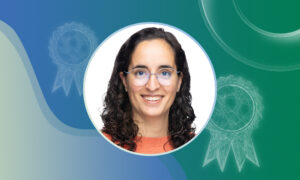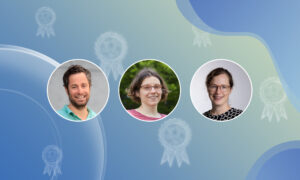
Announcing the 2025 EMBL Alumni Award recipients
Two former EMBL scientists have been recognised for their outstanding contributions to genome engineering and structural biology instrumentation.

By Tom Furnival-Adams, Alumni Relations Officer
The 2025 EMBL Alumni Award recipients have been selected.
Irma Querques, who was a predoc at EMBL Heidelberg from 2014 to 2018, has received the 2025 John Kendrew Award in recognition of her groundbreaking research in genome engineering.
Querques has elucidated innovative mechanisms for DNA editing, paving the way to breakthroughs in medicine and biotechnology. She studies transposons, also known as ‘jumping genes’ – DNA elements that move about in genomes, mostly in an unguided manner. Her work focuses on a special class of CRISPR-associated transposons which can use an RNA sequence to guide their insertion into the bacterial genome. This work is now opening up the possibility to develop new precise genome editing tools with unprecedented potential.
While the traditional CRISPR system is powerful for introducing small edits into the genome, its ability to insert large DNA payloads is restricted to cells that can carry out a specific type of DNA repair, called homologous DNA recombination. The CRISPR-associated transposons that Querques studies combine the best of both worlds by using the RNA-guided specificity of CRISPR and the DNA insertion potential of transposons, which is not dependent on homologous DNA recombination. Querques’s discoveries have led to new patents and could lead to more precise and safer gene editing that can be applied to any cell type.
A dedicated science communicator, Querques actively promotes dialogue on the scientific, ethical, and societal aspects of genome editing. She has contributed to platforms like Nature Bioengineering & Biotechnology and leveraged her experience from EMBL to engage diverse audiences through TED talks, science festivals, and interdisciplinary performances. As a professor and mentor, she also inspires younger generations. Querques is currently an assistant professor and Group Leader at the University of Vienna and Max Perutz Labs. She studied Biotechnology at the University of Bologna and performed postdoctoral research in Martin Jinek’s lab at the University of Zurich. She has received several awards, including the Branco Weiss Fellowship, an ERC Starting Grant, and the Vallee Scholar Award.
“I am truly honoured to receive the John Kendrew Award 2025,” Querques said. “EMBL has given me so much more than just exceptional scientific training – it’s where I found a strong sense of community and the freedom to explore new ideas, like my passion for transposons (and even sharing it with the public through hip-hop dancing!). The core values of integrity, inclusion, and openness continue to shape my path as a researcher, educator, and advisor. I am especially grateful that my research in transposon biology and its applications is being recognised, particularly since it was a niche field when I started my PhD. A big thanks to my mentors and colleagues for inspiring me to embrace change and new perspectives in my (scientific) life.”
Florent Cipriani, who led the EMBL Grenoble Instrumentation Team from 2003 to 2020, has been awarded the 2025 Lennart Philipson Award in recognition of his exceptional contributions to structural biology instrumentation.
As Head of the EMBL Instrumentation Team, Cipriani led the development of a number of pioneering technologies, resulting in over 30 inventions. These include micro-diffractometers, robotic sample changers, and, jointly with J.A. Márquez (Grenoble HTX team), the CrystalDirect Harvester. These innovations have advanced automation, throughput, and precision in macromolecular crystallography.
Cipriani’s innovations have had a global impact, transforming how structural biology experiments are conducted worldwide. Many of these innovations have been licensed to commercial partners and are implemented at synchrotron radiation facilities globally. Several of these are also used in the material sciences.
Cipriani’s contributions have facilitated thousands of structure-determination experiments, significantly advancing biomedical research and the development of life-saving drugs and diagnostics.
Cipriani trained as an engineer and began his career in industrial companies before joining EMBL Grenoble in 1991. “I spent nearly 30 years in Grenoble developing beamline instruments to help structural biologists carry out their most challenging projects,” he said. “In the early ‘90s, at the newly built ESRF crystallography beamlines, several hours were necessary to collect an X-ray diffraction data set. Today, it only takes a few seconds, and beamlines can operate in a pipeline with our automated crystal harvesting system. It is a great honour to see our work awarded. I am particularly grateful to Stephen Cusack for his trust and support over the years, and to EMBLEM for its key contribution in making our instruments available to the global scientific community.”
The 2025 EMBL Alumni Awards will be presented at the annual EMBL Alumni Awards ceremony at EMBL Heidelberg on Friday 11 July 2025. All EMBL staff and alumni are invited to attend, and registration details will be available soon. Nominations and applications for the 2026 John Kendrew and Lennart Philipson Awards, as well as the 2026 Kafatos Lecture, are now open. Click here to learn more.


